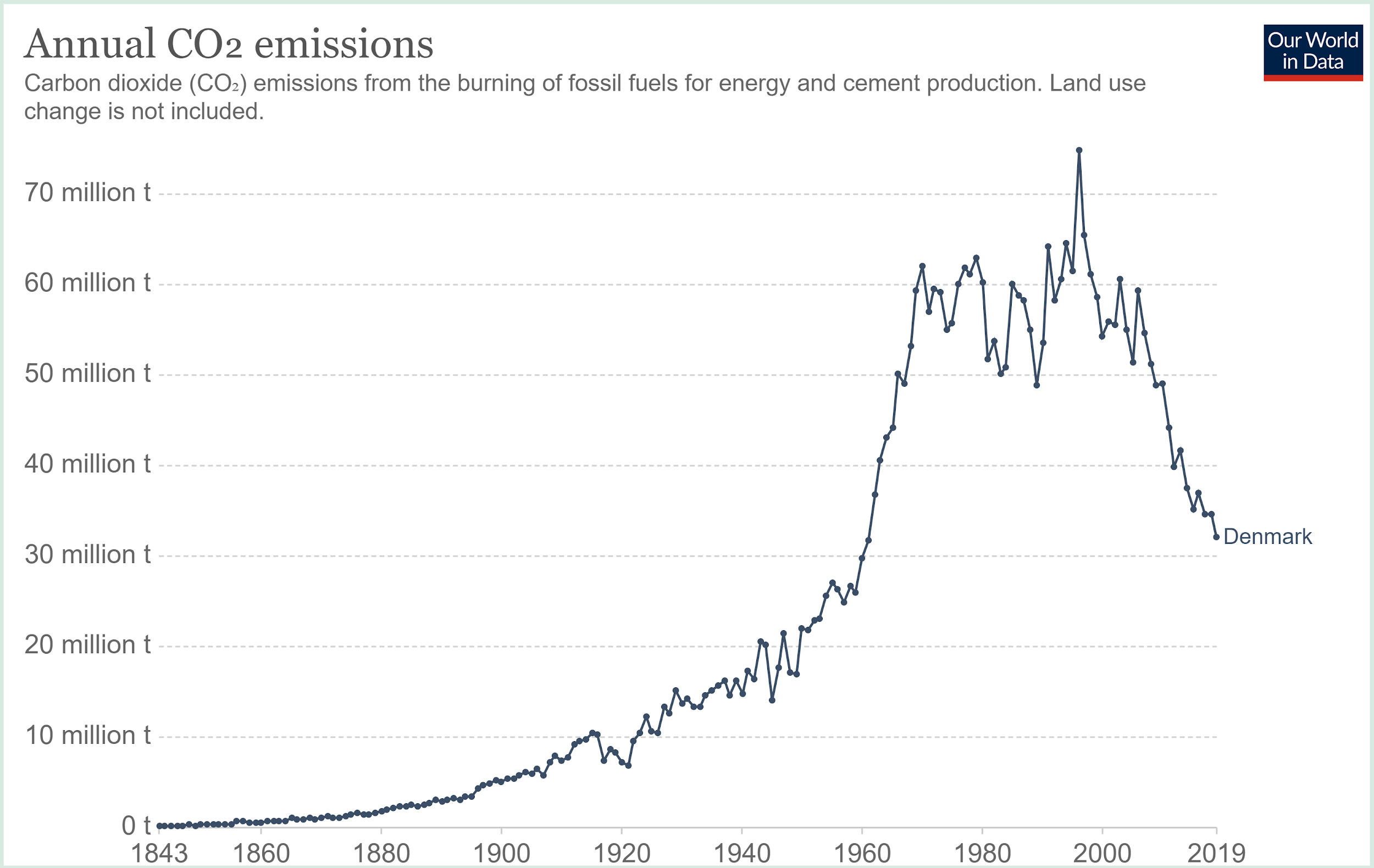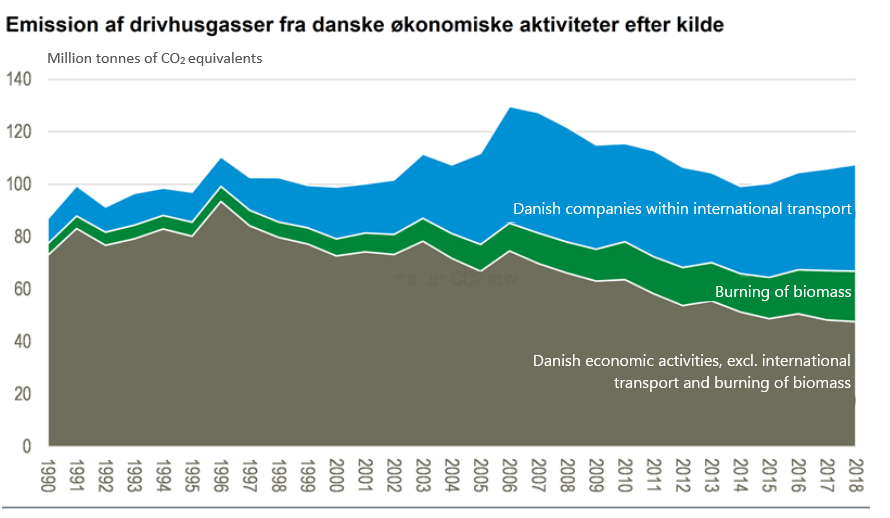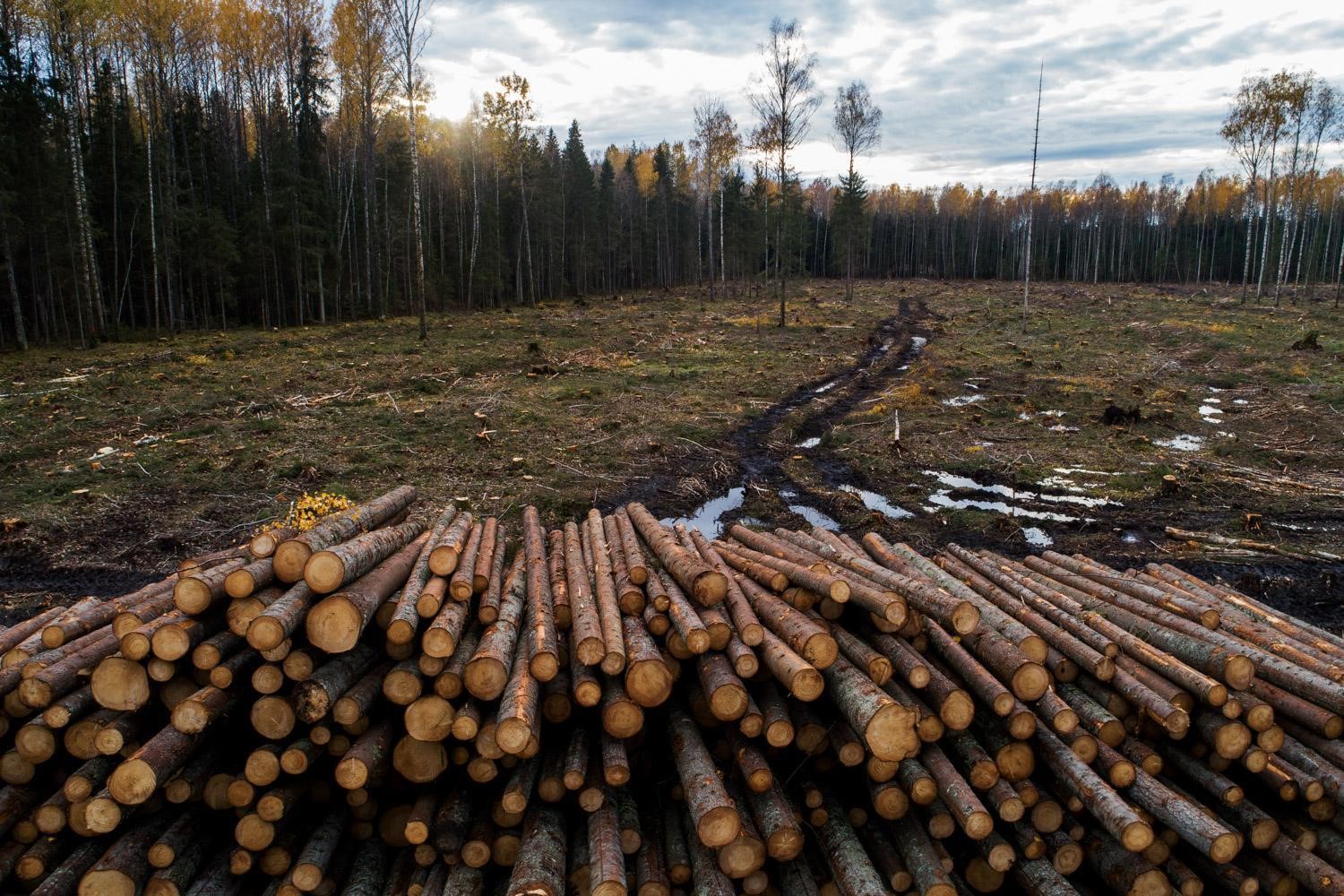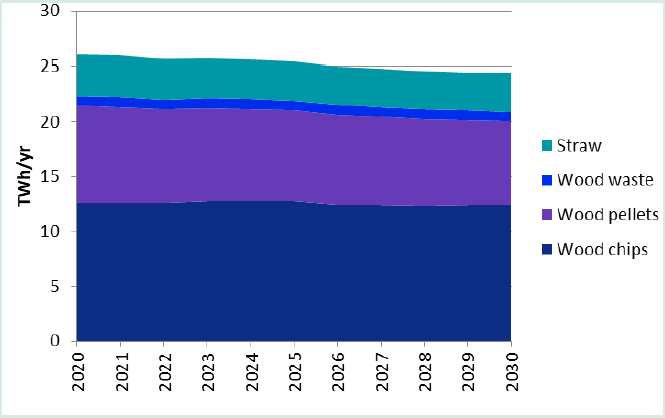Biomass consumption in Denmark and the hidden emissions
Denmark, one of the smallest countries in Europe, is recognised worldwide for its overall performance on the Sustainable Development Goals (SDGs), climate mitigation policies, and its offshore wind farms which expand into the North Sea.1,2,3 According to research published by Our World in Data, the annual CO2 emissions of Denmark have fallen by 40% (Fig. 1) within the last three decades (1990-2019).4 This information has been published by the Danish Energy Agency5 and it is distributed throughout the public and the media. However, this article examines the other side of the coin and shows that this description of climate policies does not represent the real story - or at least, the whole story.

Biomass use and incentives
Data from the Danish Energy Agency’s, Biomass Analysis, shows that most of the decline in CO2 emissions (63%), occurred in the heating and electricity sector. During this period of decline, biomass became the most prevailing source of renewable energy.6 During the same period (1990-2018), the overall Danish production of energy from solid biomass increased 275%5 from approximately 39 PJ to 150 PJ*, as it is illustrated in Figure 2. This rapid increase occurred due to biomass’s exemption from energy and CO2 taxes, when they are used for heat and electricity production. This exemption from energy taxes in particular, has been a very strong incentive shifting energy producers towards biomass consumption. Until early 2021, biomass used for heating even had a tax advantage over heat pumps, which are based upon renewable forms of electricity (e.g. from wind and solar). In the past, there has even been direct support of DKK 0.15/kWh for electricity production.6,7 However, this has been phased out. It is less attractive to build new plants 8 based on biomass today.**

The reason why policies that escalated biomass consumption were enacted was that burning biomass is considered to have zero emissions towards the entity who burns them and is not included in the international climate accounting systems of the energy sector.9 The argument is that those emissions have already been recorded and accounted for in the land use, land-use change and forestry (LULUCF) sector.10
Although emissions from biomass burning are not included in the accounting of GHG emissions, a yearly “memo item” is required to be sent to UNFCCC regarding the use of biomass, as is done in the National Inventory Report. For Denmark, it was documented that the emissions from burning solid biomass have increased from around 4 million tonnes CO2 in 1990 to around 19 million tonnes in 2019.11,12 Thereafter, even if the policy about carbon neutrality of biomass has been introduced as helping to achieve the emission reduction targets,9 it has disorientated nations like Denmark away from focusing on other renewable energy sources and forms of emissions reduction.
Large-scale transition based on imports
The amount of imported biomass is 44% of the total consumption (including domestic straw and bio-waste) in Denmark,5 as is shown in Figure 2. If we consider woody biomass (wood pellets, wood chips, wood waste, and firewood), this percentage is slightly higher. Yet, the highest consumption of woody biomass is by using wood pellets. The percentage of imported wood pellets reached 95% in 2018. Since 2010, they are the main source of solid biomass and have mainly been used to replace coal in the Combined Heat & Energy Production (CHP) sector. As Figure 2 shows, there were no imported pellets in 1990, but it became by far the largest proportional biomass fuel source today and the primary contributor to the transition from coal to biomass.6 We can therefore conclude that the reported decline in emissions of Denmark is largely attributed to a significant increase in biomass consumption from imported sources.
According to the Danish Climate Council (2018), the global estimate for sustainable biomass potential is about 100 EJ per year till 2050. Further increases could amplify the risks associated with biodiversity, food production, and land availability.8,13 These recommended estimates can also be found from the IPCC. Of the 100 EJ biomass potential, only a small percentage should come from woody biomass. In those cases where woody biomass is used, the total biomass energy consumption per person should correspond to 10 GJ per year. However, the biomass consumption for energy in Denmark was 27 GJ per person in 2018, out of which, 20 GJ was woody biomass.6 Hence, Denmark uses much more energy than its fair share and presents a challenge to biodiversity, food production, and land availability.
Sustainability issues
In Life Cycle Assessments (LCAs) applied at the EU level; accounting of biomass for Greenhouse Gas (GHG) emissions exclude biogenic CO2 at the place of combustion.
Therefore, the methodology that the Renewable Energy Directives (RED & RED II) use, does not record the actual GHG emissions from the energy sector.14
According to IPCC, when considering the Lifecycle Emissions of biomass, biogenic CO2 is the most important factor contributing to emissions. Moreover, woody biomass contributes to much higher CO2 emissions in comparison to wind and solar energy. More specifically, when the contribution of each source is estimated, the highest emissions derive from biogenic CO2 and surface albedo, followed by the infrastructure and supply chains.15 As an increasing share of the biomass is imported, GHG emissions from transport are also escalating.6 A recent research showed that when forest carbon change was included in LCAs, the GHG emissions were even higher than sourcing fossil fuels.16 The emissions from biomass per unit of energy are similar to the emissions released from coal.17
The Biomass Analysis from the Danish Energy Agency (2020) critically highlights that even if biomass production according to their calculations contributes to only 5-25% of emissions in comparison to fossil fuels, this is still much higher than using wind or solar energy. Since calculations of carbon emissions from biomass burning are not taken into account, it is remarkable that biomass is still regarded as the least sustainable renewable source. Furthermore, the analysis describes that forest mismanagement due to demand for energy production is very likely to have more extreme impacts on climate change than the use of coal.6
According to the Biomass Analysis, there is no accessible data that provides adequate information about the impact of biomass consumption in Denmark.6 However, Statistics Denmark published the emissions from bioenergy, as seen in Figure 3. If these were included in the Danish climate reduction goal, they would look quite different. Since 1990, the emissions from bioenergy have increased by 15 million tonnes CO2e. (excluding the LULUCF sector).18 Much of these emissions do not even occur in the Danish LULUCF sector, since nearly half of the biomass is imported.

Another statement mentioned in Biomass Analysis is that according to Matthews et al. (2015), some of the best practices to reduce CO2 would be to prioritize biomass produced at the EU level, limiting imports from non-EU countries.6 However, when looking further into Matthews’s quantitative reporting, it is highlighted that one of the limitations of the assessment is that there are a lot of uncertainties regarding the “most likely” responses in wood use and forest management.19 These uncertainties are verified by evidence showing risks in forest management in Estonia and Latvia (Fig. 4), which will be explained further later in this article.20

The Danish Energy Agency that published the Biomass Analysis, also points out that the EU Renewable Energy Directive (RED II) includes insufficient sustainability requirements for biomass fuels from the forestry sector concerning the imports from specific countries. In Denmark, almost 40% of imported woody biomass is shipped from non-EU countries. The US and Russia are examples of countries from which Denmark imports biomass and which neither have mitigation targets that include the LULUCF sector, or whose LULUCF estimates are subject to scrutiny whether they represent and include emissions against binding targets. In 2018, Russia and the US together supplied around one-quarter of the biomass imported by Denmark for energy purposes. Therefore, a decline in the reported emissions in Denmark could have fostered global emissions that are not accounted for in either country.6
A decline in carbon storage of European forests
The European Commission documented in 2016 that the carbon storage of European forests has been declining since 2010 and is expected to decline further due to, among other things, increased demand for biomass for energy.10 According to the policy report from the European Commission (2021) about the use of woody biomass for energy purposes in the EU, the amount of primary woody biomass that has been used for energy production is at least 37%. Furthermore, 14% of the total use is uncategorized (primary or secondary wood), meaning that the use of primary wood can be close to 50%.14
The European Commission has assessed that demand for biomass could foster additional harvesting of trees and forest residues (stumps and coarse deadwood) needed for producing energy. This could trigger various risks, leading to negative impacts on climate, biodiversity, the quality of air and soil. The report states that “biogenic emissions vary over time and different results are obtained for GHG emissions depending on the time horizon considered. An immediate increase in GHG emissions compared to using fossil fuels is almost inevitable, as combustion emissions of biomass are higher than those of fossil alternatives”. Furthermore, that “the initial period of increased GHG emissions can vary from less than one year to hundreds of years (or even to infinity in the worst cases, if no savings can be realised), depending on the type of forest bioenergy pathway”.18 Consequently, it is very risky to stick with biomass and consider it as a zero contributor of emissions when the climate is already unstable and many years have to pass for new trees to grow.
The European Commission also concludes that there is a higher risk regarding the magnitude of emissions when energy demand through biomass consumption is increased. At the same time, in 2023 bioenergy is still expected to be the so-called renewable source of energy with the highest share - 46% worldwide and 59% in the EU.21,22 Denmark’s national plan is to keep consuming almost the same amount of energy through bioenergy and especially wood pellets and wood chips till 2030, as it is shown in Figure 5 below.6

Origin of the imported wood
The utmost amount (46%) of wood pellets comes from the Baltic countries (Latvia and Estonia) and 30% from the USA, Canada and Russia.6 Estonia and Latvia have steadily been the primary exporters of biomass to Denmark, mainly in the form of wood pellets and wood chips. According to Kuresoo et al. (2020), the rate of forest logging for wood pellets has been increased in both Latvia and Estonia and the authors claim that it is amplified by the global demand for woody biomass. Logging is also happening in Natura 2000 areas (Fig. 6) and it has contributed to the decline of rare species.20 Also, the net removals of GHGs in the LULUCF sector in Latvia have decreased by 114% during the last three decades (1990-2018). This is mainly caused by the increase in harvest rate of mature forests.23

Brazil is an example of a non-EU country that exports wood to Denmark. In February 2020, the Danish television station, TV2, broadcasted that Denmark has also imported wood from Eucalyptus plantations in the Brazilian Amazon. More specifically, it referred to wood chips derived from the Cerrado of Amapa, one of the most endangered and least protected regions of the Amazonian savanna. TV2 sharply criticized this action and questioned the sustainability of those plantations of Eucalyptus,24,25 as this woody biomass (although referred to as “sustainable”) was derived from areas that were previously covered with flora and fauna species precious for biodiversity and climate.
Scientists speak up
In addition to the above arguments, more than 500 scientists have recently signed a letter regarding the use of forests for bioenergy. The letter was sent to the President of the European Commission (Ursula von der Leyen), President of the US (Joe Biden), Prime Minister of Japan (Yoshihide Suga), President of the European Council (Charles Michel) and the President of South Korea (Moon Jae-in). Scientists highlight that in recent years, forest biomass and particularly whole tree trunks have been used for producing heat and energy. They claim that these practices contribute to carbon emissions and “carbon debt”, since the burning of wood will intensify impacts of climate change and will last for decades to centuries, as regrowth of trees takes time. Also, forest harvesting in Europe has been increased with higher demand for bioenergy and since sustainability criteria have not altered this trend. Therefore, scientists urge policymakers to cease subsidies and other incentives provided for the promotion of forest biomass use; moreover, that biomass should not be considered carbon neutral in the EU.26 That has also been our request at NOAH. Since 2015, we have claimed that biomass should not be considered a renewable form of energy anymore. Thankfully, many more people are now advocating this standpoint.
* The exact figures according to Energistatistik 2019 from the Danish Energy Agency are: 39,252 TJ in 1990 to 149,554 TJ in 2019 (out of which 83,629 TJ was produced domestically and 65,925 TJ was imported).
** This reflects a societal shift in the positive attitude towards biomass. The tax exemptions are not being phased out although there is a societal discussion about them. Αccording to calculations by E,ON., they constitute around DKK 6 billion DKK annually. https://bit.ly/3x9QH4E
References
- Sachs, J., Schmidt-Traub, G., Kroll, C., Lafortune, G., Fuller, G., Woelm, F. (2020). The Sustainable Development Goals and COVID-19. Sustainable Development Report 2020. Cambridge: Cambridge University Press. p. 25, 26 & 41.
- Burck, J., Hagen, U., Höhne, N., Nascimento, L., Bals, C. (2020). Climate Change Performance Index 2021.
- Gronholt-Pedersen, J. (2020). Denmark sources record 47% of power from wind in 2019. Published online at Reuters.com
- Ritchie, H. and Roser, M. (2020). "CO₂ and Greenhouse Gas Emissions". Published online at OurWorldInData.org.
- Energistyrelsen (2019). Data, tabeller, statistikker og kort. [Data, tables, statistics and maps]. p. 3 & 40.
- Danish Energy Agency (2020). Biomass Analysis. p. 5, 9, 10, 13-15, 26, 28, 29, 31, 34.
- Sørensen, P.B., Elmeskov, J., Frederiksen, P., Jacobsen, J.B., Kristensen, N.B., Morthorst, P.E. and Richardson, K. (2016). Kloge afgifter skal hjælpe den grønne omstilling [Wise taxes should help the green transition]. Danish Council on Climate Change. Klimarådet
- Sørensen, P.B., Elmeskov, J., Frederiksen, P., Jacobsen, J.B., Kristensen, N.B., Morthorst, P.E. and Richardson, K. (2018). Biomassens betydning for grøn omstilling. [The importance of biomass for green conversion]. Klimarådet
- EU Directive (2018). DIRECTIVE (EU) 2018/2001 OF THE EUROPEAN PARLIAMENT AND OF THE COUNCIL on the promotion of the use of energy from renewable sources.
- European Commission (2016). IMPACT ASSESSMENT. Proposal for a REGULATION OF THE EUROPEAN PARLIAMENT AND OF THE COUNCIL on the inclusion of greenhouse gas emissions and removals from land use, land use change and forestry into the 2030 climate and energy framework and amending Regulation No 525/2013 of the European Parliament and the Council on a mechanism for monitoring and reporting greenhouse gas emissions and other information relevant to climate change.
- Nielsen, O.K., Plejdrup, M.S., Winther, M., Nielsen, M., Gyldenkærne, S., Mikkelsen, M.H., Albrektsen, R., Thomsen, M., Hjelgaard, K., Fauser, P., Bruun, H.G., Johannsen, V.K., Nord-Larsen, T., Vesterdal, L., Callesen, I., Caspersen, O.H., Rasmussen, E., Petersen, S.B., Baunbæk, L. & Hansen, M.G. (2020). Denmark's National Inventory Report 2020. Emission Inventories 1990-2018 - Submitted under the United Nations Framework Convention on Climate Change and the Kyoto Protocol. Aarhus University, DCE – Danish Centre for Environment and Energy 904 pp. Scientific Report from DCE – Danish Centre for Environment and Energy No. 372.
- Statistics Denmark (2020). Greenhouse Gas Accounts (in CO2 equivalents) by industry and type of emission.
- Chum, H., Faaij, A., Moreira, J., … Pingoud, K. (2011). Bioenergy. In IPCC Special Report on Renewable Energy Sources and Climate Change Mitigation, Cambridge University Press, Cambridge, United Kingdom and New York, NY, USA. p. 214.
- Camia A., Giuntoli, J., Jonsson, R., Robert, N., Cazzaniga, N.E., Jasinevičius, G., Avitabile, V., Grassi, G., Barredo, J.I., Mubareka, S. (2021). The use of woody biomass for energy purposes in the EU, EUR 30548 EN, Publications Office of the European Union, Luxembourg. p. 7, 98, 101 & 143.
- Bruckner, T., Bashmakov, I.A., Mulugetta, Y., ... Zhang X. (2014). Energy Systems. In: Climate Change 2014: Mitigation of Climate Change. Contribution of Working Group III to the Fifth Assessment Report of the Intergovernmental Panel on Climate Change. Cambridge University Press, Cambridge, United Kingdom and New York, NY, USA. p. 539.
- Liu, W., Zhang, Z., Xie, X. et al. (2017). Analysis of the Global Warming Potential of Biogenic CO2 Emission in Life Cycle Assessments.
- Zanchi, G., Pena, N., & Bird, N. (2010). The upfront carbon debt of bioenergy.
- Danmarks Statistik (2019). Mere CO2 fra afbrænding af biomasse [More CO2 from burning biomass].
- Matthews, R., Mortimer, N., Lesschen, J.P., Lindroos, T.J., Sokka, L., Morris, A., ... & Sayce, M. (2015). Carbon impacts of biomass consumed in the EU: quantitative assessment. Final report, project: DG ENER C, 1. p. xviii.
- Kuresoo, S., Kuresoo, L., Lilleväli, U., and Kerus, V. (2020). Hidden inside a wood pellet. Intensive logging impacts in Estonian and Latvian forests. Estonian Fund for Nature & Latvian Ornithological Society.
- European Commission (2016). Impact Assessment. Sustainability of Bioenergy. p. 16, 106 & 126.
- IEA (2018). Renewables 2018, IEA, Paris
- Skrebele, A., Rubene, L., Lupkina, L., Cakars, I., … Zustenieks G. Latvia’s National Inventory Report 1990 – 2018. p. 73.
- Ditzel, E.E. (2020). København brænder træ fra Amazonas for at hjælpe klimaet [Copenhagen burns wood from the Amazon to help the climate]. TV2
- Mustin, K., Carvalho, W. D., Hilário, R. R., Costa-Neto, S. V., Silva, C., Vasconcelos, I. M., ... & Toledo, J. J. (2017). Biodiversity, threats and conservation challenges in the Cerrado of Amapá, an Amazonian savanna. Nature Conservation, 22, 107.
- Raven, P. et al. (2021). Letter Regarding Use of Forests for Bioenergy.

